You are using an out of date browser. It may not display this or other websites correctly.
You should upgrade or use an alternative browser.
You should upgrade or use an alternative browser.
TerraLiner:12 m Globally Mobile Beach House/Class-A Crossover w 6x6 Hybrid Drivetrain
- Thread starter biotect
- Start date
egn
Adventurer
Now quite honestly, I don't know what to make of those private messages. Needless to say, I don't know if their experiences of having been “pounced on” here on ExPo were idiosyncratic, and I don't know what discussion on other, non-American forums tends to be like. I haven't spent enough time on the German forums, for instance, to be able to say whether they are more sympathetic to larger overlanding machines, or not. Perhaps egn or others might know?
In Germany there is no single very large forum like Expo, with discussions of vehicles ranging from small (cheap) to very large (expensive). There are a lot of smaller forums that are specialized on specific vehicle types. This prevents a lot of conflicts between enthusiastic owners o all types/sizes, that have to discuss in the "mine is better than yours" style.
Here is a short list of forums that come to my mind. Of course, there are many more. I visit only the first two regularly.
http://www.allrad-lkw-gemeinschaft.de/ (commercial and military trucks > 3,5 t, repair, building camper, oldtimer, ...)
http://www.kat-forum.de/ (MAN KAT vehicles, repair, building camper, oldtimer, ...)
http://www.offroad-forum.de/ (similar to expo with focus on smaller vehicles)
http://www.motor-talk.de/forum/offroad-b46.html (smaller vehicles)
http://www.unimog-community.de/ (Unimog)
http://www.unimurr.de/forum-unimurr/wbblite/ (Unimog)
http://www.busfreaks.de (buses, repair, building camper, oldtimer)
http://www.wohnmobilforum.de/selbstausbauer-und-leerkabinen-f11.html (building camper)
http://www.womobox.de/phpBB2/portal.php (building camper)
http://www.weltreiseforum.de/ (traveling the world)
People owning a new Unicat or similar camper don't seem to be active in the forums. There are always people that have problems meeting the corresponding other end of the vehicle range (often matching the income range), but in general at least in the first two forums the tensions are low, as support goes in both directions. This may also be a result of the many smaller and larger informal meetings during the year. During summer time nearly every weekend there is a meeting, where people can discuss and enjoy each other. This meetings create a lot of friendships between people of all vehicle sizes and income classes.
This is now getting off-topic a bit, so I stop here.
Last edited:
biotect
Designer
Hi egn,
Your post seems very on-topic, because what you just wrote explains a great deal!
When forums are more niche-specialized, there is less likelihood, say, that a participant who favors van conversions will stumble upon a MAN-KAT discussion, and feel moved to opine about the moral validity of MAN-KATs used as expedition vehicles, period..... Again, I was a bit surprised to receive some of those private messages, because my own personal experience on ExPo has been so positive. But perhaps some enthusiasts for "big overlanding" have had less than happy experiences here on ExPo? So if they are reading this thread, your explanation could help them better understand why they might have been "pounced" on in the past, in such a large forum?
On the upside, a very large, comprehensive, touch-all-bases forum like ExPo gains considerably from what economists call “network effects”: the more people who use the forum, the more valuable it becomes for everyone – see http://en.wikipedia.org/wiki/Network_effect . But on the downside, there also emerges the danger that some threads will become "cluttered” with irrelevant information. One could call this “network congestion”. It's certainly a kind of “information congestion”. No doubt some genius with a double Ph.D in economics + computer science has come up with a nice, succinct label to summarize the downside of large discussion forums.
However, as I wrote back to those who posted private messages of encouragement, I actually welcomed the criticisms that have been expressed in this thread; especially those that raised questions about the “ethics” of expedition travel by large motorhome. Those criticisms made me think, and think again.
Now to be sure, in response I wrote long apologies that defended "big overlanding". But as my next series of posts should make clear, those questions are by no means closed for me, and they continue to haunt my design process. Indeed, I found myself worrying about such questions long before I ever began posting on ExPo. For instance, the magbaz article quoted at the beginning of “The Ethics of Third World Travel by Motorhome” thread struck me so much, that when I first came across it just before Xmas, for almost a month I was strongly inclined to switch my MFA thesis project to designing a catamaran -- see http://www.magbaztravels.com/content/view/1440/324/ . After all, virtually no-one ever questions the moral validity of touring the planet via big sailing boat.....
:088:
In short, certain kinds of transportation design must face squarely some unavoidable ethical and political questions. But only on a forum as large as ExPo will those questions emerge so clearly, precisely because on ExPo there will emerge a natural temptation to “compare and criticize horses”. Perhaps those who wrote to me privately are then wrong in thinking that a tendency to "compare and criticize horses" on ExPo is a peculiarly American foible? Instead, as you suggest egn, it's probably just an accidental by-product of ExPo's large size.
So many thanks for that: your post explained a lot.
***********************************************
About MAN KATs: are you familiar with the ActionMobil MAN KAT known as “Yellow Cab”, based in Africa, and used by film crews? Just came across it on the newly revamped ActionMobil website, at http://actionmobil.com/en/world-gallery/uganda , http://actionmobil.com/en/4-axle/specials , and http://actionmobil.com/images/galleries/4achser/specials-en/04.jpg :
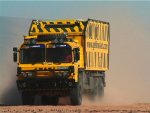


Read the fine-print, where ActionMobil writes:
“The special characteristic of this MAN military chassis is the construction of its frame. Helical [i.e. progressive coil] springs for all wheels and a distortion-free chassis facilitate gentle transport of sensitive load in extremely tough terrain. ACTION MOBIL has mounted various types of cabins on this chassis and used some of them even under rally conditions.”
Sounds a lot like the MAN SX-45, doesn't it?! :sombrero:
So to state the obvious, once again: there is nothing new or unprecedented about torsion-free frames, nor is there anything new about the idea of using such frames as better, more secure foundations for expedition camper bodies. The only thing that would have prevented the “Yellow Cab” from becoming a fully integrated design, is its CF engine placement.
***********************************************
Will post again about 3 or 4 days from now. Right now swamped with other projects and obligations......
In closing, thanks as well for that terrific short-list of the best German off-road forums.
Jetzt brauche ich nur meiner schriftlichen Deutsch zu verbessern....
All best wishes,
Biotect
Your post seems very on-topic, because what you just wrote explains a great deal!
When forums are more niche-specialized, there is less likelihood, say, that a participant who favors van conversions will stumble upon a MAN-KAT discussion, and feel moved to opine about the moral validity of MAN-KATs used as expedition vehicles, period..... Again, I was a bit surprised to receive some of those private messages, because my own personal experience on ExPo has been so positive. But perhaps some enthusiasts for "big overlanding" have had less than happy experiences here on ExPo? So if they are reading this thread, your explanation could help them better understand why they might have been "pounced" on in the past, in such a large forum?
On the upside, a very large, comprehensive, touch-all-bases forum like ExPo gains considerably from what economists call “network effects”: the more people who use the forum, the more valuable it becomes for everyone – see http://en.wikipedia.org/wiki/Network_effect . But on the downside, there also emerges the danger that some threads will become "cluttered” with irrelevant information. One could call this “network congestion”. It's certainly a kind of “information congestion”. No doubt some genius with a double Ph.D in economics + computer science has come up with a nice, succinct label to summarize the downside of large discussion forums.
However, as I wrote back to those who posted private messages of encouragement, I actually welcomed the criticisms that have been expressed in this thread; especially those that raised questions about the “ethics” of expedition travel by large motorhome. Those criticisms made me think, and think again.
Now to be sure, in response I wrote long apologies that defended "big overlanding". But as my next series of posts should make clear, those questions are by no means closed for me, and they continue to haunt my design process. Indeed, I found myself worrying about such questions long before I ever began posting on ExPo. For instance, the magbaz article quoted at the beginning of “The Ethics of Third World Travel by Motorhome” thread struck me so much, that when I first came across it just before Xmas, for almost a month I was strongly inclined to switch my MFA thesis project to designing a catamaran -- see http://www.magbaztravels.com/content/view/1440/324/ . After all, virtually no-one ever questions the moral validity of touring the planet via big sailing boat.....
:088:
In short, certain kinds of transportation design must face squarely some unavoidable ethical and political questions. But only on a forum as large as ExPo will those questions emerge so clearly, precisely because on ExPo there will emerge a natural temptation to “compare and criticize horses”. Perhaps those who wrote to me privately are then wrong in thinking that a tendency to "compare and criticize horses" on ExPo is a peculiarly American foible? Instead, as you suggest egn, it's probably just an accidental by-product of ExPo's large size.
So many thanks for that: your post explained a lot.
***********************************************
About MAN KATs: are you familiar with the ActionMobil MAN KAT known as “Yellow Cab”, based in Africa, and used by film crews? Just came across it on the newly revamped ActionMobil website, at http://actionmobil.com/en/world-gallery/uganda , http://actionmobil.com/en/4-axle/specials , and http://actionmobil.com/images/galleries/4achser/specials-en/04.jpg :



Read the fine-print, where ActionMobil writes:
“The special characteristic of this MAN military chassis is the construction of its frame. Helical [i.e. progressive coil] springs for all wheels and a distortion-free chassis facilitate gentle transport of sensitive load in extremely tough terrain. ACTION MOBIL has mounted various types of cabins on this chassis and used some of them even under rally conditions.”
Sounds a lot like the MAN SX-45, doesn't it?! :sombrero:
So to state the obvious, once again: there is nothing new or unprecedented about torsion-free frames, nor is there anything new about the idea of using such frames as better, more secure foundations for expedition camper bodies. The only thing that would have prevented the “Yellow Cab” from becoming a fully integrated design, is its CF engine placement.
***********************************************
Will post again about 3 or 4 days from now. Right now swamped with other projects and obligations......
In closing, thanks as well for that terrific short-list of the best German off-road forums.
Jetzt brauche ich nur meiner schriftlichen Deutsch zu verbessern....
All best wishes,
Biotect
Last edited:
biotect
Designer
Just a parenthetical addition:
Recently came across a document that some might find interesting. It's titled “World Product Standards”, and was produced by the “2[SUP]nd[/SUP] World RV Conference”, held in Tampa, Florida, in 2013 – see http://www.rvia.org/UniPop.cfm?v=2&OID=699&CC=8160 . A few sample pages:

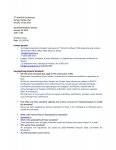
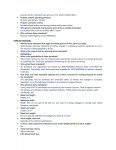


Because the workshop was so recent, the information that it contains is at most about a year old. It then runs through summaries of standards covering just about every aspect of RV design, for:
1. Australia
2. Brazil
3. Canada
4. Germany
5. Japan
6. Russia
7. South Africa
8. The United States
The document is literally saturated with web-links. Let me know what you think!
Also came across a more dated summary of "North American" rules (2007), i.e. Canada + the United States (and not Mexico?), on a state-by-state and province-by-province basis. But the range of topics covered is more limited, if only because the same categories are repeated for over 60 entries – see http://www.woodalls.com/articledetails.aspx?articleID=1195129 . Interesting that most Canadian provinces seems to limit motorhomes to 12.5 m (i.e. 41 feet), in contrast to most American states where the limit is 45 feet.
Americans reading this post may already be familiar with the second document, and/or the information that it contains. But it might prove useful for non-Americans.
All best wishes,
Biotect
Recently came across a document that some might find interesting. It's titled “World Product Standards”, and was produced by the “2[SUP]nd[/SUP] World RV Conference”, held in Tampa, Florida, in 2013 – see http://www.rvia.org/UniPop.cfm?v=2&OID=699&CC=8160 . A few sample pages:





Because the workshop was so recent, the information that it contains is at most about a year old. It then runs through summaries of standards covering just about every aspect of RV design, for:
1. Australia
2. Brazil
3. Canada
4. Germany
5. Japan
6. Russia
7. South Africa
8. The United States
The document is literally saturated with web-links. Let me know what you think!
Also came across a more dated summary of "North American" rules (2007), i.e. Canada + the United States (and not Mexico?), on a state-by-state and province-by-province basis. But the range of topics covered is more limited, if only because the same categories are repeated for over 60 entries – see http://www.woodalls.com/articledetails.aspx?articleID=1195129 . Interesting that most Canadian provinces seems to limit motorhomes to 12.5 m (i.e. 41 feet), in contrast to most American states where the limit is 45 feet.
Americans reading this post may already be familiar with the second document, and/or the information that it contains. But it might prove useful for non-Americans.
All best wishes,
Biotect
Last edited:
egn
Adventurer
Sounds a lot like the MAN SX-45, doesn't it?! :sombrero:
No, it is a KAT 1A1 with air-cooled Deutz 513 engine.
The only thing that would have prevented the “Yellow Cab” from becoming a fully integrated design, is its CF engine placement.
... and/or the budget.
LoRoad
Adventurer
Not sure if I follow you? ... Biotect
And I'm not sure that's a question or if it's a comment. Either way - best of luck to you.
biotect
Designer
Hi LoRoad,
It was actually a genuine question....
From the semi-technical nature of your language -- e.g. "given the premeditation of your statement" -- you seem to be a lawyer by training? If you are, then your grip on these issues is no doubt better than mine.
Even still, as already indicated, would prefer to proceed cautiously and anonymously, at least for now, while it's still "early days". This is a long-term project (the next 15 months), so personally speaking I'm in no particular rush. If those reading this want to get to the "punch-line" finish immediately now, then best to avoid the thread for the next 15 months, and come back, say, circa June 2015.......
I've already promised that I will eventually share my designs and drawings, but at the right moment.
All best wishes,
Biotect
It was actually a genuine question....
From the semi-technical nature of your language -- e.g. "given the premeditation of your statement" -- you seem to be a lawyer by training? If you are, then your grip on these issues is no doubt better than mine.
Even still, as already indicated, would prefer to proceed cautiously and anonymously, at least for now, while it's still "early days". This is a long-term project (the next 15 months), so personally speaking I'm in no particular rush. If those reading this want to get to the "punch-line" finish immediately now, then best to avoid the thread for the next 15 months, and come back, say, circa June 2015.......
I've already promised that I will eventually share my designs and drawings, but at the right moment.
All best wishes,
Biotect
Last edited:
biotect
Designer
Hi egn,
My use of the English idiomatic expression, "sounds a lot like", was perhaps too ambiguous. When using this expression, I intended it to mean, "seems similar to", and not "is identical with".
Earlier in the post I already made it clear that I knew that the “Yellow Cab” is a MAN-KAT vehicle, and not an SX-45. So perhaps the intended first possible meaning, "seems similar to", was obvious enough? I only wanted to suggest that the frame + coil suspension of this particular MAN-KAT seems similar to the arrangement advertised for the SX-45. It was not my intention to claim that the “Yellow Cab” is itself actually an SX-45.
Unfortunately the expression, “ sounds a lot like”, does seems to have these two possible meanings in English, and you seem to have interpreted my sentence via the second meaning.....
**************************************
Now on the one hand I am inclined to agree with you about budget. Moving the Yellow Cab's engine to the back, and building a fully integrated camper shell, would have been expensive.
But on the other hand, I also find myself asking:
Would it really prove so expensive? In the long run? Over a production run of multiple iterations of the same basic vehicle design?
Yes, agreed, to move the Yellow Cab's engine to the back, and create an integrated “Pusher” design for just one vehicle, would prove expensive.
But realistically speaking, if integrated designs ever do emerge in the expedition-motorhome market, that's not how they will come about. Why? Well, because that's not how integrated designs emerged in the mainstream motorhome market.
**************************************
1. Fully Integrated Mining-Transportation Buses as precedents for Fully Integrated Expedition Motorhomes
This question about cost arose for me because of the links that Joe just recently posted, for Australian off-road integrated bus and motorhome designs, on page 18 of this thread at http://www.expeditionportal.com/for...pedition-RV-w-Rigid-Torsion-Free-Frame/page18.
In particular, I was inspired by the links that Joe posted for:
(1) Some off-road Australian mining-transportation buses, fully integrated, based on either the Iveco Eurocargo ML150 4x4 chassis, or the Iveco Trakker 6x6 chassis.
and
(2) The custom-built, "bespoke" Australian off-road luxury motorhome, fully integrated, based on a MAN 18.284 4x4 chassis.
See http://www.autobus.com.au , http://www.autobus.com.au/vehicles , http://www.autobus.com.au/vehicles/iveco-tonto4/standard , http://www.autobus.com.au/vehicles/iveco-tonto6/standard , http://www.autobus.com.au/media/pdfs/abc-mag/abc-mag-2.pdf , http://quality-bus.com/pdf/Tonto_New.pdf , https://www.bus4x4.com.au , http://www.bus4x4.com.au/vehicles , http://www.bus4x4.com.au/vehicles/iveco-tonto4/standard , http://www.bus4x4.com.au/vehicles/iveco-tonto6/standard , https://www.bus4x4.com.au/media/pdfs/vehicle-range/range-overview.pdf , https://www.bus4x4.com.au/media/pdfs/vehicle-range/range-4x4motorhome.pdf , https://www.bus4x4.com.au/media/pdfs/vehicle-range/range-toyota.pdf , http://www.4x4motorhomes.com.au , http://www.4x4motorhomes.com.au/about-us , http://www.4x4motorhomes.com.au/vehicles , http://www.4x4motorhomes.com.au/vehicles/toyota-coaster/motorhome-build , http://www.4x4motorhomes.com.au/media/wysiwyg/gallery/index.html , http://www.outbacktravelaustralia.com.au/buyers-guide-4x4-campervan/bus-4x4-coaster-4wd-campervan , http://www.iveco.com/en-us/press-room/kit/Pages/Trakker_ar_detail.aspx , http://www.4x4motorhomes.com.au/media/wysiwyg/motorhome/index.html , and http://www.thompsons.au.com/motorhome/ .
Here I provide an abundance of links for the Australian off-road bus company, because it seems to maintain multiple websites with different names: "Autobus", "Bus 4x4", and "4x4 Motorhomes". These websites share a great deal of information in common, but not everything, and it's a bit maddening because one has to surf 70 % similar content no less than 3 times, simply in order to extract the 30 % that's different. Let's just say that researching this particular company was confusing, and even more confusing given that their larger, Iveco Trakker-based bus shells are manufactured by yet another company, Quality Bus & Coach, based in Malaysia.
This Australian company -- or family of companies -- makes and sells wonderful vehicles with terrific 3D designs, but it sure could invest a bit more in the 2D flat stuff, i.e. web design and graphic design. So to simplify matters, in what follows below I will call this company "4x4 Motorhomes", no matter which website is referenced.
With that gripe out of the way, here are some images and videos of their wonderfully integrated, off-road buses and motorhomes:









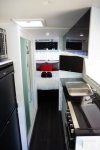
As the above videos and images suggest, 4x4 Motorhomes not only sells integrated bus bodies mounted on Iveco 4x4 and 6x6 chassis, but also does 4x4 van conversions using Toyota, Isuzu, and Ford Transit chassis. Some of the very beautiful interior and exterior images above were from 4x4 Motorhomes's most recent van conversion, which they call their Toyota "Demo Coaster". 4x4 Motorhomes is clearly a diversified company, offering a range of products including mainstream on-road buses, off road 4x4 and 6x6 mining-transportation buses, on-road van-conversion RV's, off-road van-conversion RV's, and even off-road ambulance van-conversions!
But the comments in the next few posts apply specifically to their larger, Iveco-based, off-road mining-transportation bus, pictured in the first two rows of images above, called the "Tonto".
***********************************
CONTINUED IN NEXT POST
.
My use of the English idiomatic expression, "sounds a lot like", was perhaps too ambiguous. When using this expression, I intended it to mean, "seems similar to", and not "is identical with".
Earlier in the post I already made it clear that I knew that the “Yellow Cab” is a MAN-KAT vehicle, and not an SX-45. So perhaps the intended first possible meaning, "seems similar to", was obvious enough? I only wanted to suggest that the frame + coil suspension of this particular MAN-KAT seems similar to the arrangement advertised for the SX-45. It was not my intention to claim that the “Yellow Cab” is itself actually an SX-45.
Unfortunately the expression, “ sounds a lot like”, does seems to have these two possible meanings in English, and you seem to have interpreted my sentence via the second meaning.....
**************************************
Now on the one hand I am inclined to agree with you about budget. Moving the Yellow Cab's engine to the back, and building a fully integrated camper shell, would have been expensive.
But on the other hand, I also find myself asking:
Would it really prove so expensive? In the long run? Over a production run of multiple iterations of the same basic vehicle design?
Yes, agreed, to move the Yellow Cab's engine to the back, and create an integrated “Pusher” design for just one vehicle, would prove expensive.
But realistically speaking, if integrated designs ever do emerge in the expedition-motorhome market, that's not how they will come about. Why? Well, because that's not how integrated designs emerged in the mainstream motorhome market.
**************************************
1. Fully Integrated Mining-Transportation Buses as precedents for Fully Integrated Expedition Motorhomes
This question about cost arose for me because of the links that Joe just recently posted, for Australian off-road integrated bus and motorhome designs, on page 18 of this thread at http://www.expeditionportal.com/for...pedition-RV-w-Rigid-Torsion-Free-Frame/page18.
In particular, I was inspired by the links that Joe posted for:
(1) Some off-road Australian mining-transportation buses, fully integrated, based on either the Iveco Eurocargo ML150 4x4 chassis, or the Iveco Trakker 6x6 chassis.
and
(2) The custom-built, "bespoke" Australian off-road luxury motorhome, fully integrated, based on a MAN 18.284 4x4 chassis.
See http://www.autobus.com.au , http://www.autobus.com.au/vehicles , http://www.autobus.com.au/vehicles/iveco-tonto4/standard , http://www.autobus.com.au/vehicles/iveco-tonto6/standard , http://www.autobus.com.au/media/pdfs/abc-mag/abc-mag-2.pdf , http://quality-bus.com/pdf/Tonto_New.pdf , https://www.bus4x4.com.au , http://www.bus4x4.com.au/vehicles , http://www.bus4x4.com.au/vehicles/iveco-tonto4/standard , http://www.bus4x4.com.au/vehicles/iveco-tonto6/standard , https://www.bus4x4.com.au/media/pdfs/vehicle-range/range-overview.pdf , https://www.bus4x4.com.au/media/pdfs/vehicle-range/range-4x4motorhome.pdf , https://www.bus4x4.com.au/media/pdfs/vehicle-range/range-toyota.pdf , http://www.4x4motorhomes.com.au , http://www.4x4motorhomes.com.au/about-us , http://www.4x4motorhomes.com.au/vehicles , http://www.4x4motorhomes.com.au/vehicles/toyota-coaster/motorhome-build , http://www.4x4motorhomes.com.au/media/wysiwyg/gallery/index.html , http://www.outbacktravelaustralia.com.au/buyers-guide-4x4-campervan/bus-4x4-coaster-4wd-campervan , http://www.iveco.com/en-us/press-room/kit/Pages/Trakker_ar_detail.aspx , http://www.4x4motorhomes.com.au/media/wysiwyg/motorhome/index.html , and http://www.thompsons.au.com/motorhome/ .
Here I provide an abundance of links for the Australian off-road bus company, because it seems to maintain multiple websites with different names: "Autobus", "Bus 4x4", and "4x4 Motorhomes". These websites share a great deal of information in common, but not everything, and it's a bit maddening because one has to surf 70 % similar content no less than 3 times, simply in order to extract the 30 % that's different. Let's just say that researching this particular company was confusing, and even more confusing given that their larger, Iveco Trakker-based bus shells are manufactured by yet another company, Quality Bus & Coach, based in Malaysia.
This Australian company -- or family of companies -- makes and sells wonderful vehicles with terrific 3D designs, but it sure could invest a bit more in the 2D flat stuff, i.e. web design and graphic design. So to simplify matters, in what follows below I will call this company "4x4 Motorhomes", no matter which website is referenced.
With that gripe out of the way, here are some images and videos of their wonderfully integrated, off-road buses and motorhomes:










As the above videos and images suggest, 4x4 Motorhomes not only sells integrated bus bodies mounted on Iveco 4x4 and 6x6 chassis, but also does 4x4 van conversions using Toyota, Isuzu, and Ford Transit chassis. Some of the very beautiful interior and exterior images above were from 4x4 Motorhomes's most recent van conversion, which they call their Toyota "Demo Coaster". 4x4 Motorhomes is clearly a diversified company, offering a range of products including mainstream on-road buses, off road 4x4 and 6x6 mining-transportation buses, on-road van-conversion RV's, off-road van-conversion RV's, and even off-road ambulance van-conversions!
But the comments in the next few posts apply specifically to their larger, Iveco-based, off-road mining-transportation bus, pictured in the first two rows of images above, called the "Tonto".
***********************************
CONTINUED IN NEXT POST
.
Last edited:
biotect
Designer
.
CONTINUED FROM PREVIOUS POST
***********************************
Next, here are some more images of that custom-built, Australian off-road luxury motorhome, fully integrated, based on a MAN 18.284 4x4 chassis -- again, see http://www.thompsons.au.com/motorhome/ :

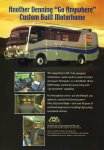



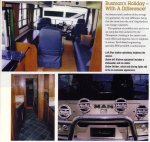


Joe, once again, many thanks for this lead!
Observe that this integrated motorhome even has a built-in Jacuzzi bath-tub…..:REExeSwimmingHL:... And yet this vehicle's camper-body, as well as the bus-shells of the Tontos in the previous post, all seem to be mounted on flexible frames – frames that should in theory be unable to accommodate fully integrated designs?.. ..
..
As far as I know, Iveco only makes trucks that have frames that flex every bit as much as the frames made by MAN (with the notable exception of the SX-45) -- see http://www.iveco.com/uk/products/pages/new-trakker-robust-frame-in-high-yield-strength-steel.aspx and http://web.iveco.com/africa-mideast-en/products/pages/trakker_frame_and_suspension.aspx . So the Tontos sold by 4x4 Motorhomes are a bit of a "structural mystery", as is this Australian custom-built integrated motorhome mounted on a (presumably) flexible MAN chassis-frame. If anyone reading this has some thoughts as to how they accomplished this, please chime in! Or if there's something special about Iveco truck frames, please elucidate.
Furthermore, notice how in both cases the fabricators simply left the engine in place, and did not go through the trouble of relocating the engine to the rear, i.e. to a “Pusher” placement as you have been advocating, egn. In the case of the MAN-based integrated design, they simply built the camper floor around the engine, opting for an "access hatch", as per the Decoliner, which you and I briefly discussed on page 17, near the bottom – see http://www.expeditionportal.com/for...pedition-RV-w-Rigid-Torsion-Free-Frame/page17 :


If you recall, you did not like the idea of this sort of access hatch, because it means that a mechanic will have to enter the motorhome proper to do repairs.
In the case of the Iveco-conversion Tonto I could not find photographs of the engine placement. But an article that appeared in “Australian Bus & Coach”, June 2013, makes it clear that here too the engine was not moved (see page 65, http://www.autobus.com.au/media/pdfs/abc-mag/abc-mag-2.pdf ):
“Under the front passenger and driver compartment lies a 6-litre 280hp (210kW) Iveco Tector engine. The European heritage of the engine means that it uses selective catalytic reduction (SCR) to satisfy ADR 80/03 (Euro 5) emissions regulations.
Behind the Tector powerplant is a 6-speed manual ZF transmission taking care of gear changing duties, and a hydraulically assisted clutch helping the engine talk to the tranny.”
So perhaps CF engine placement is in fact quite compatible with a fully integrated design?
No doubt much here will depend on the size and height of the engine, and how it mounts in the chassis frame.
**************************************
2. The Budget Implications
The budget implications are then as follows.
The Iveco-based Tonto is a mining-transportation vehicle intended for use in Australia's booming resource-extraction industry, whose dramatic expansion over the last two decades is a direct consequence of huge Chinese demand. Australia has not had a recession in over 20 years, and it can largely thank Chinese economic expansion for that – see http://www.macrobusiness.com.au/2013/09/is-the-australian-economy-recession-proof/ and http://www.huffingtonpost.com/2013/03/06/australia-recession_n_2818610.html . Buoyant economies tend to support risky, creative experimentation, so it's perhaps no surprise that the Tonto is a joint Australian-Malayan creation.
Again, the article in Australian Bus & Coach provides a nice account of the Tonto's genesis. The default tendency in the world of mining transportation, just like the world of expedition motorhomes, has been to simply stick a camper box on the back of a pre-existing truck chassis+cab. But this solution does not make the best possible use of the real-estate provided by the chassis:
“Aussie operators who like to get down and dirty with their passengers are currently spoilt for choice in the off-road bus segment. It's a hand spin-off from the [Chinese demand-driven] mining and resources boom, however, many of the true 4x4 products available tend to be truck-based.
This makes sense as many of the large truck makers have an established range of 4x4 trucks and established dealer networks around the country. Again this also makes sense, as due to the very nature of their job description these trucks aren't exactly hanging around the suburbs, they are out in the middle of nowhere. You want to be withing reach of qualified help if something does break.
The downside of some of these truck-based products though is that many of them are a truck with a passenger body fitted to the back instead of a cargo bed [sound familiar?}. While this is an easy and economical way to turn a truck into a bus, just ask the Cubans, it doesn't tend to make the most of the real estate provided by the chassis. A body builder fitting a complete bus body to a truck chassis is always going to be able to squeeze more seats and better facilities into a coach body rather than by just fitting a ban body with windows onto a cab chassis….
Bus 4x4 is the Australian agent for Quality Bus and Coach and handles the Tonto as well as two other Autobus models locally. The end result is a truck-based bus that actually looks like a bus.” – see http://www.autobus.com.au/media/pdfs/abc-mag/abc-mag-2.pdf
Now to be sure, the initial investment in the tools and moulds required to produce an integrated bus-shell like the Tonto must have been substantial. And it probably helps that this shell is manufactured by Quality Bus & Coach in Malaysia, where labor is comparatively inexpensive – see http://quality-bus.com , http://site.quality-bus.com/main/4090/index.asp?pageid=124938 , http://site.quality-bus.com/main/4090/index.asp?pageid=126248 , and http://quality-bus.com/pdf/Tonto_New.pdf .
The Australian company, in this case called either Bus 4x4 or Autobus Australia (again, it's not clear which.... ), seems to merely distribute the Tonto. The initial concept of the Tonto seems to have been a joint-venture between Iveco Australia and Quality Bus & Coach; although as Joe suggested, it seems that the design work was done in Queensland, perhaps by Iveco Australia based there?
), seems to merely distribute the Tonto. The initial concept of the Tonto seems to have been a joint-venture between Iveco Australia and Quality Bus & Coach; although as Joe suggested, it seems that the design work was done in Queensland, perhaps by Iveco Australia based there?
But now that the investment has been made, it's then just a small, additional step to propose the same chassis + bus-shell combination for use as a large 4x4 or 6x6 off-road motorhome – see http://www.4x4motorhomes.com.au/vehicles/iveco-tonto4/motorhome and http://www.4x4motorhomes.com.au/vehicles/iveco-tonto6/motorhome . So far it doesn't seem as if there have been many takers. But with threads like this one priming the pump of potential interest, who knows? At the very least, the mere existence of the Tonto and 4x4 Motorhomes suggest that quite a few people began thinking along the lines explored in this thread years ago. And that the time does seem ripe for fully integrated, very large expedition motorhomes to begin appearing.
***********************************
CONTINUED IN NEXT POST
.
CONTINUED FROM PREVIOUS POST
***********************************
Next, here are some more images of that custom-built, Australian off-road luxury motorhome, fully integrated, based on a MAN 18.284 4x4 chassis -- again, see http://www.thompsons.au.com/motorhome/ :






Joe, once again, many thanks for this lead!
Observe that this integrated motorhome even has a built-in Jacuzzi bath-tub…..:REExeSwimmingHL:... And yet this vehicle's camper-body, as well as the bus-shells of the Tontos in the previous post, all seem to be mounted on flexible frames – frames that should in theory be unable to accommodate fully integrated designs?..
As far as I know, Iveco only makes trucks that have frames that flex every bit as much as the frames made by MAN (with the notable exception of the SX-45) -- see http://www.iveco.com/uk/products/pages/new-trakker-robust-frame-in-high-yield-strength-steel.aspx and http://web.iveco.com/africa-mideast-en/products/pages/trakker_frame_and_suspension.aspx . So the Tontos sold by 4x4 Motorhomes are a bit of a "structural mystery", as is this Australian custom-built integrated motorhome mounted on a (presumably) flexible MAN chassis-frame. If anyone reading this has some thoughts as to how they accomplished this, please chime in! Or if there's something special about Iveco truck frames, please elucidate.
Furthermore, notice how in both cases the fabricators simply left the engine in place, and did not go through the trouble of relocating the engine to the rear, i.e. to a “Pusher” placement as you have been advocating, egn. In the case of the MAN-based integrated design, they simply built the camper floor around the engine, opting for an "access hatch", as per the Decoliner, which you and I briefly discussed on page 17, near the bottom – see http://www.expeditionportal.com/for...pedition-RV-w-Rigid-Torsion-Free-Frame/page17 :

If you recall, you did not like the idea of this sort of access hatch, because it means that a mechanic will have to enter the motorhome proper to do repairs.
In the case of the Iveco-conversion Tonto I could not find photographs of the engine placement. But an article that appeared in “Australian Bus & Coach”, June 2013, makes it clear that here too the engine was not moved (see page 65, http://www.autobus.com.au/media/pdfs/abc-mag/abc-mag-2.pdf ):
“Under the front passenger and driver compartment lies a 6-litre 280hp (210kW) Iveco Tector engine. The European heritage of the engine means that it uses selective catalytic reduction (SCR) to satisfy ADR 80/03 (Euro 5) emissions regulations.
Behind the Tector powerplant is a 6-speed manual ZF transmission taking care of gear changing duties, and a hydraulically assisted clutch helping the engine talk to the tranny.”
So perhaps CF engine placement is in fact quite compatible with a fully integrated design?
No doubt much here will depend on the size and height of the engine, and how it mounts in the chassis frame.
**************************************
2. The Budget Implications
The budget implications are then as follows.
The Iveco-based Tonto is a mining-transportation vehicle intended for use in Australia's booming resource-extraction industry, whose dramatic expansion over the last two decades is a direct consequence of huge Chinese demand. Australia has not had a recession in over 20 years, and it can largely thank Chinese economic expansion for that – see http://www.macrobusiness.com.au/2013/09/is-the-australian-economy-recession-proof/ and http://www.huffingtonpost.com/2013/03/06/australia-recession_n_2818610.html . Buoyant economies tend to support risky, creative experimentation, so it's perhaps no surprise that the Tonto is a joint Australian-Malayan creation.
Again, the article in Australian Bus & Coach provides a nice account of the Tonto's genesis. The default tendency in the world of mining transportation, just like the world of expedition motorhomes, has been to simply stick a camper box on the back of a pre-existing truck chassis+cab. But this solution does not make the best possible use of the real-estate provided by the chassis:
“Aussie operators who like to get down and dirty with their passengers are currently spoilt for choice in the off-road bus segment. It's a hand spin-off from the [Chinese demand-driven] mining and resources boom, however, many of the true 4x4 products available tend to be truck-based.
This makes sense as many of the large truck makers have an established range of 4x4 trucks and established dealer networks around the country. Again this also makes sense, as due to the very nature of their job description these trucks aren't exactly hanging around the suburbs, they are out in the middle of nowhere. You want to be withing reach of qualified help if something does break.
The downside of some of these truck-based products though is that many of them are a truck with a passenger body fitted to the back instead of a cargo bed [sound familiar?}. While this is an easy and economical way to turn a truck into a bus, just ask the Cubans, it doesn't tend to make the most of the real estate provided by the chassis. A body builder fitting a complete bus body to a truck chassis is always going to be able to squeeze more seats and better facilities into a coach body rather than by just fitting a ban body with windows onto a cab chassis….
Bus 4x4 is the Australian agent for Quality Bus and Coach and handles the Tonto as well as two other Autobus models locally. The end result is a truck-based bus that actually looks like a bus.” – see http://www.autobus.com.au/media/pdfs/abc-mag/abc-mag-2.pdf
Now to be sure, the initial investment in the tools and moulds required to produce an integrated bus-shell like the Tonto must have been substantial. And it probably helps that this shell is manufactured by Quality Bus & Coach in Malaysia, where labor is comparatively inexpensive – see http://quality-bus.com , http://site.quality-bus.com/main/4090/index.asp?pageid=124938 , http://site.quality-bus.com/main/4090/index.asp?pageid=126248 , and http://quality-bus.com/pdf/Tonto_New.pdf .
The Australian company, in this case called either Bus 4x4 or Autobus Australia (again, it's not clear which....
But now that the investment has been made, it's then just a small, additional step to propose the same chassis + bus-shell combination for use as a large 4x4 or 6x6 off-road motorhome – see http://www.4x4motorhomes.com.au/vehicles/iveco-tonto4/motorhome and http://www.4x4motorhomes.com.au/vehicles/iveco-tonto6/motorhome . So far it doesn't seem as if there have been many takers. But with threads like this one priming the pump of potential interest, who knows? At the very least, the mere existence of the Tonto and 4x4 Motorhomes suggest that quite a few people began thinking along the lines explored in this thread years ago. And that the time does seem ripe for fully integrated, very large expedition motorhomes to begin appearing.
***********************************
CONTINUED IN NEXT POST
.
Last edited:
biotect
Designer
.
CONTINUED FROM PREVIOUS POST
***********************************
3. The Transition to Fully Integrated Motorhomes in the Mainstream RV Industry
**************************************
The question one then wants to ask is:
Does such design experimentation have to mining-boom funded? Can it only arise this way, and no other?
Just consider: if the investment to develop such an integrated camper body for other chassis platforms (e.g. MAN, Tatra) were so enormous – so enormous that it would present an insurmountable challenge – then integrated designs in the Class A and German “Liner” markets should not even exist. And yet integrated Class A and German “Liner” motorhomes do exist. At some point, manufacturers like Hymer and Concorde just did have to make the transition to fully integrated styling.
In the case of Hymer, this occurred some time in the early 1970's, with the introduction of the 660 model – see http://www.hireahymer.com/about-us/the-history-of-hymer-motorhomes/the-history-2/ :

In other words, almost 50 years after Hymer was first founded in 1923, it finally came out with an integrated motorhome – see http://www.hymer.com/en/company/historie.html , http://www.hireahymer.com/about-us/the-history-of-hymer-motorhomes/ , http://www.erwin-hymer-museum.de/en/start.html , http://www.motorhoming.com/motorhome-spotlight/535-hymer . Albeit granted, Hymer only began producing caravans in earnest in the late 1950's. And after a “false-start” fabricating a few motorhomes in the early 1960's, Hymer only began serious production of semi-integrated motorhomes in 1971.
Concorde's history demonstrates a similar lag. Founded in 1981, Concorde produced its first fully integrated model only 16 years later, in 1997 – see http://www.concorde.eu/en/the-company/history/ .
Over in the United States, however, Winnebagos seem to have been fully integrated right from the beginning, with the very first motorhomes produced in 1966 – see http://ballew.org/winnebago/winnebago.html , http://www.winnebagoind.com/company/about-us/story.php , http://www.fundinguniverse.com/company-histories/winnebago-industries-inc-history/ , http://www.motorhoming.com/motorhome-spotlight/534-winnebago , and http://ballew.org/winnebago/winnebago.html , http://www.winnebagoparts.com/justforfun.php :

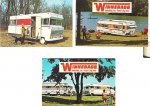
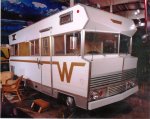

But granted, most mainstream RV manufacturers continue to produce partially integrated models to round out their product line-up, no doubt because semi-integrated models can still hit lower price-points – see http://www.buerstner.com/uk/the_company/history.html and http://www.buerstner.com/uk/motorhomes.html .
**************************************
4. An Inevitable Transition
So, in a way, this thread has been asking a rather obvious and “inevitable” sort of question:
Who will be the first off-road expedition motorhome manufacturer to offer a fully integrated model?
That one of them eventually will, seems clear enough, given the history of the mainstream RV industry. But the pioneer here might not be ActionMobil or UniCat. After all, both are heavily invested in bespoke, hand-craft production processes and personnel. It might require a bit of an outsider like Quality Bus & Coach in Malaysia to see the potential, capitalizing on its prior investment in bus-shell production for Australian mining-transportation vehicles. Or perhaps more accurately, Quality Bus & Coach working in concert with 4x4 Motorhomes?
But once produced in volume, in production runs, costs would fall, and perhaps such motorhomes might cost even less than the hand-crafted, non-integrated off-road motorhomes of the kind produced so far. The market might also significantly expand, because quite honestly, how many people have the time and energy necessary to go through the elaborate design-process of specifying a completely custom expedition motorhome? It's not just the price of UniCats or ActionMobils that might put many people off, but also the work involved in thinking through all the possible design choices. Whereas if more “standardized” 6x6 integrated motorhomes similar to the Tonto were to become available, and if they cost 30 or 40 % less than an ActionMobil or Unicat equivalent (say, 500,000 instead of 800,000), one could imagine a whole new class of potential owners emerging.
All best wishes,
Biotect
CONTINUED FROM PREVIOUS POST
***********************************
3. The Transition to Fully Integrated Motorhomes in the Mainstream RV Industry
**************************************
The question one then wants to ask is:
Does such design experimentation have to mining-boom funded? Can it only arise this way, and no other?
Just consider: if the investment to develop such an integrated camper body for other chassis platforms (e.g. MAN, Tatra) were so enormous – so enormous that it would present an insurmountable challenge – then integrated designs in the Class A and German “Liner” markets should not even exist. And yet integrated Class A and German “Liner” motorhomes do exist. At some point, manufacturers like Hymer and Concorde just did have to make the transition to fully integrated styling.
In the case of Hymer, this occurred some time in the early 1970's, with the introduction of the 660 model – see http://www.hireahymer.com/about-us/the-history-of-hymer-motorhomes/the-history-2/ :

In other words, almost 50 years after Hymer was first founded in 1923, it finally came out with an integrated motorhome – see http://www.hymer.com/en/company/historie.html , http://www.hireahymer.com/about-us/the-history-of-hymer-motorhomes/ , http://www.erwin-hymer-museum.de/en/start.html , http://www.motorhoming.com/motorhome-spotlight/535-hymer . Albeit granted, Hymer only began producing caravans in earnest in the late 1950's. And after a “false-start” fabricating a few motorhomes in the early 1960's, Hymer only began serious production of semi-integrated motorhomes in 1971.
Concorde's history demonstrates a similar lag. Founded in 1981, Concorde produced its first fully integrated model only 16 years later, in 1997 – see http://www.concorde.eu/en/the-company/history/ .
Over in the United States, however, Winnebagos seem to have been fully integrated right from the beginning, with the very first motorhomes produced in 1966 – see http://ballew.org/winnebago/winnebago.html , http://www.winnebagoind.com/company/about-us/story.php , http://www.fundinguniverse.com/company-histories/winnebago-industries-inc-history/ , http://www.motorhoming.com/motorhome-spotlight/534-winnebago , and http://ballew.org/winnebago/winnebago.html , http://www.winnebagoparts.com/justforfun.php :




But granted, most mainstream RV manufacturers continue to produce partially integrated models to round out their product line-up, no doubt because semi-integrated models can still hit lower price-points – see http://www.buerstner.com/uk/the_company/history.html and http://www.buerstner.com/uk/motorhomes.html .
**************************************
4. An Inevitable Transition
So, in a way, this thread has been asking a rather obvious and “inevitable” sort of question:
Who will be the first off-road expedition motorhome manufacturer to offer a fully integrated model?
That one of them eventually will, seems clear enough, given the history of the mainstream RV industry. But the pioneer here might not be ActionMobil or UniCat. After all, both are heavily invested in bespoke, hand-craft production processes and personnel. It might require a bit of an outsider like Quality Bus & Coach in Malaysia to see the potential, capitalizing on its prior investment in bus-shell production for Australian mining-transportation vehicles. Or perhaps more accurately, Quality Bus & Coach working in concert with 4x4 Motorhomes?
But once produced in volume, in production runs, costs would fall, and perhaps such motorhomes might cost even less than the hand-crafted, non-integrated off-road motorhomes of the kind produced so far. The market might also significantly expand, because quite honestly, how many people have the time and energy necessary to go through the elaborate design-process of specifying a completely custom expedition motorhome? It's not just the price of UniCats or ActionMobils that might put many people off, but also the work involved in thinking through all the possible design choices. Whereas if more “standardized” 6x6 integrated motorhomes similar to the Tonto were to become available, and if they cost 30 or 40 % less than an ActionMobil or Unicat equivalent (say, 500,000 instead of 800,000), one could imagine a whole new class of potential owners emerging.
All best wishes,
Biotect
Last edited:
biotect
Designer
Joe,
Clearly, all of the above thinking was directly inspired by your terrific posts. So again, many thanks. Your two posts generated so many questions for me, that I did not know where to start. The previous was just the beginning; I have many additional queries, which should gradually emerge in subsequent posts.
The MAN-based integrated motorhome and those Tonto mining-transport buses were extraordinarily suggestive, and they much more nearly resemble what I had always imagined an ideal, Liner-type expedition vehicle should look like. It's also perhaps not surprising that such vehicles were first created in Australia, because the Australian off-road specialist industry seems especially advanced and innovative. See for instance my post about Kimberley on page 14, about 2/3 of the way down, at http://www.expeditionportal.com/for...orsion-Free-Frame/page14?highlight=integrated . And of course there's companies like ARB and Gordigear – see http://www.arb.com.au and http://www.gordigear.com/roof_tents/roof_tents.php?l=en – as well as Eco-Tourer, http://www.ecotourer.com.au , whose web-link you provided on page 18, at http://www.expeditionportal.com/for...orsion-Free-Frame/page18?highlight=integrated .
Thanks for that, too; and more anon about fabric versus hard-sided pop-ups.
Now Iveco + Quality Bus & Coach working together developed the Tonto as a niche-product to serve Australian mining transportation in particular, where it stands to reason that demand exists for specialized off-road buses to ferry crews across difficult terrain to worksites. This then suggests a potentially fruitful direction for future research: investigating whether other, similar specialist mining-transportation vehicles have emerged elsewhere. Mining is a global industry, and over the last 15 years Chinese demand has dramatically raised commodity prices worldwide, leading to massive capital investment in resource extraction – and, presumably, new mining transport vehicles everywhere.
I haven't begun doing any such research. But once I do, if I discover something terrific down that road, I will have you to thank.
So too, I'll be investigating Icelandic off-road tourist buses – another excellent lead!
All best wishes,
Biotect
Last edited:
biotect
Designer
egn,
Now that I was looking for it, found a good image of the Tonto's engine-tunnel and its CF or COE placement (not sure what to call it?), on one of the YouTube videos:

See http://www.youtube.com/watch?v=D_GnF4zsyF8#t=82 , about 40 % of the way in.
Again suggesting that a fully integrated design + a far-forward driving position that maximizes visibility, does not have to entail "Pusher" engine placement.
Sure, one might still want Pusher placement for other reasons, e.g. noise. Although according to one review, the Iveco's "Tector" engine in particular is not noisy at all -- see http://www.autobus.com.au/media/pdfs/abc-mag/abc-mag-2.pdf , pg. 66:
"The Tector engine is renowned for its quiet operation and in this bus it didn't disappoint. The synchromesh manual gearshift was easy to live withand I found there was very little rumble through the body while out on the asphalt, which is surprising considering the huge cleated super single tyres that were pounding the ground outside."
All best wishes,
Biotect
Now that I was looking for it, found a good image of the Tonto's engine-tunnel and its CF or COE placement (not sure what to call it?), on one of the YouTube videos:

See http://www.youtube.com/watch?v=D_GnF4zsyF8#t=82 , about 40 % of the way in.
Again suggesting that a fully integrated design + a far-forward driving position that maximizes visibility, does not have to entail "Pusher" engine placement.
Sure, one might still want Pusher placement for other reasons, e.g. noise. Although according to one review, the Iveco's "Tector" engine in particular is not noisy at all -- see http://www.autobus.com.au/media/pdfs/abc-mag/abc-mag-2.pdf , pg. 66:
"The Tector engine is renowned for its quiet operation and in this bus it didn't disappoint. The synchromesh manual gearshift was easy to live withand I found there was very little rumble through the body while out on the asphalt, which is surprising considering the huge cleated super single tyres that were pounding the ground outside."
All best wishes,
Biotect
Last edited:
tacr2man
Adventurer
Modern cabover European trucks (even 600hp) , are very quiet in the cab , probably due insulation , both noise , and the cab , being fully mounted on its own suspension system . The medium bus (21 seater) BUS4x4 is a Toyota , as used for airport transfer , and extensively in Australia as a school bus ( i operated one) the body is very stiff , to roll over protection standard and with integral seatbelt mountings on all seats, as are others EG Mitsubishi Rosa. Some manufacturers pulled out of OZ market due this requirement (market too small) . From my experience the only chassis that did not twist was PinZ, and haflinger . tatra (certain models) use the tubular central spine system as well . Even the large box section landrover chassis twist a bit , on extreme terrain. HTSH
biotect
Designer
The medium bus (21 seater) BUS4x4 is a Toyota , as used for airport transfer , and extensively in Australia as a school bus ( i operated one) the body is very stiff , to roll over protection standard and with integral seatbelt mountings on all seats, as are others EG Mitsubishi Rosa. Some manufacturers pulled out of OZ market due this requirement (market too small) . From my experience the only chassis that did not twist was PinZ, and haflinger . tatra (certain models) use the tubular central spine system as well . Even the large box section landrover chassis twist a bit , on extreme terrain. HTSH
tacr2man,
Very interesting information about the 4x4 Toyota "Coaster", and its stiff body/frame provided as rollover protection -- see http://en.wikipedia.org/wiki/Toyota_Coaster , http://www.toyota.com.au/coaster , http://www.toyota.com.au/coaster/fe...?WT.ac=VHCoasterFeaturesLHNavInteriorExterior , and http://www.toyota.com.au/coaster/features/safety?WT.ac=VHCoasterFeaturesLHNavSafety .
Are you sure that this level of protection comes factory-standard from Toyota? Or does Bus 4x4 add an "internal rollover protection system" as part of its mining-transport specification, or off-road transport specification -- see http://www.bus4x4.com.au/vehicles/toyota-coaster/mine-spec and http://www.bus4x4.com.au/media/pdfs/vehicles/4x4-coaster-brochure.pdf ?
Also, any thoughts about how Bus4x4 (or 4x4 Motorhomes, or Autobus Australia, or whatever they're called....





To be completely accurate, this vehicle -- called the "Tonto" -- is made by Quality Coach & Bus in Malaysia, and was developed in concert with Iveco Australia -- see http://quality-bus.com , http://site.quality-bus.com/main/4090/index.asp?pageid=124938 , http://site.quality-bus.com/main/4090/index.asp?pageid=126248 , and http://quality-bus.com/pdf/Tonto_New.pdf . But Bus4x4 distributes the Tonto, so perhaps you might know?
There is nothing on Iveco's website that describes or characterizes the Eurocargo ML150 4x4's frame as particularly stiff or rigid -- see http://www.iveco.com.au/index.php/off-road/eurocargo-4x4/eurocargo-range and http://www.iveco.com.au/index.php/off-road/eurocargo-4x4/eurocargo-4x4-frame-suspension . And likewise, nothing that stands out as exceptional about the chassis-frame of the Trakker 6x6 -- see http://www.iveco.com.au , http://www.iveco.com.au/index.php/off-road , http://www.iveco.com.au/index.php/off-road/trakker , and http://www.iveco.com.au/index.php/off-road/trakker/trakker-frame-suspension . So it's a bit of a mystery how the Tonto's integrated bus-shell mounts on top of either Iveco chassis, if the chassis-frame is still flexible, as per most truck-frames (with the exceptions, as you suggest, of Tatra and Pinzgauer). If the Iveco chassis is indeed flexible, then the Tonto shell would have to mount on a secondary pivoting sub-frame, right?
Also note that the "mining buses" featured on Iveco Australia's own website seem to be not nearly as capable as the Tonto, and are only 4x2 and 6x2 -- see http://www.iveco.com.au/index.php/bus-coach/mining and http://www.iveco.com.au/index.php/bus-coach/mining/delta-eurorider .
All best wishes,
Biotect
Last edited:
biotect
Designer
.
*************************************
All About Mañana
*************************************
Just thought I should post some information in this thread that recently came my way, about the Australian fully-integrated MAN conversion in particular, already discussed a few posts back.
The vehicle is called "Mañana"; for an extensive description, illustrated with lots of images, see http://www.thompsons.au.com/motorhome/:
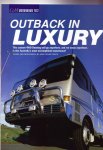




Because Mañana is such a unique and important vehicle, I emailed some questions to its original owner, Mr. Peter Thompson, on the off-chance that he might be willing to reply (Mr. Thompson successfully sold the motorhome about a month ago).
Mr. Thompson’s response was very generous, and the following provides a summary of our ensuing email exchange:
In addition, I asked Mr. Thompson a few questions about some of the more unique interior features of Mañana.
A few of his more noteworthy responses were as follows:
************************************
1. Engine Placement


************************************
2. Refrigerator
***********************************
Personally speaking, I found the details about the Thompson’s refrigerator fascinating. It seems clear that in an offroad motorhome a Danfoss 12 V compressor is the way to go. But if one’s motorhome is a large luxury model, as per the Thompsons', and if one has the space available, what if one wants the storage capacity of a big domestic refrigerator? At 300 L, the Thompson’s refrigerator was in the same ballpark as the largest RV refrigerators purpose-built by Dometic and Thetford, which are 12.3 cu feet and 17.0 cu feet respectively, or 348 L and 481 L. But those Dometic and Thetford models are gas-absorption.
Now Nova Kool does make a line of all-electric marine refrigerators, specifically designed to handle tilting to 30 degrees, and these refrigerators are now fitted in many expedition motorhomes and truck-campers – see http://www.novakool.com and http://www.novakool.com/documents/30ANGLE2011.pdf . But Nova Kool’s biggest refrigerator is 9 cubic feet, or 258 L, still somewhat short of the Thompson's Kelvinator at 300 L – see http://www.novakool.com/products/two_doors/rfu6200_6800_8000_9000.htm .
In short, the Thompson’s solution was simple, elegant, energy efficient, and off-road capable. Because the Thompson’s refrigerator used Danfoss compressor technology as opposed to gas-absorption, off-road tilting was not a problem; and once it was converted to 12V power, electricity consumption was no longer a problem either. Many comments on recent RV forums even suggest that, from the point of view of thermal efficiency, contemporary domestic compressor-based refrigerators significantly out-perform gas-absorption models built for RV’s. The only drawback is that domestic 120 V or 240 V compressor refrigerators need an inverter, and the power drain of the inverter tends to nullify their superior thermal efficiency. The obvious and simple solution, then, would be to do as the Thompsons did, dispensing with the inverter by replacing the compressor and control unit with a Danfoss 12 V.
I then did a bit of web-research to see what other experienced RV-ers might think about this solution, and it turns out that there's much to recommend it – see for instance the extensive discussions at http://caravanersforum.com/viewtopic.php?f=2&t=14721 and http://www.cruisersforum.com/forums/f115/240vac-danfoss-compressor-to-12vdc-danfoss-64493.html . The only drawback, of course, is the initial up-front cost of installing a Danfoss 12 V compressor and control unit. But over the long haul this cost might be more than recouped given the superior energy consumption of a 12 V fridge versus a 240 V model – see http://hobohome.com/news/?p=457 .
From a design point of view, this then means that one might have the full spectrum of domestic fridges to choose from, including Sub-Zero’s all-glass-door models, as installed in Newell coaches. It’s also worth noting that Sub-Zero fridges are extremely energy efficient.
***********************************
In sum, the Thompson's off-road motorhome was/still is an innovative and exceptional vehicle, and when originally built was immediately recognized as path-breaking. Mr. Thompson kindly gave me his permission to repost the information here, so in closing, I would once more like to thank him for his generosity.
All best wishes,
Biotect
*************************************
All About Mañana
*************************************
Just thought I should post some information in this thread that recently came my way, about the Australian fully-integrated MAN conversion in particular, already discussed a few posts back.
The vehicle is called "Mañana"; for an extensive description, illustrated with lots of images, see http://www.thompsons.au.com/motorhome/:



Because Mañana is such a unique and important vehicle, I emailed some questions to its original owner, Mr. Peter Thompson, on the off-chance that he might be willing to reply (Mr. Thompson successfully sold the motorhome about a month ago).
Mr. Thompson’s response was very generous, and the following provides a summary of our ensuing email exchange:
- After delivery from Europe, the MAN 18.284 4x4 chassis was lengthened by MAN in Queensland, Australia. But to Mr. Thompson’s knowledge, the chassis was not radically stiffened or strengthened
- The body of the motorhome was built in 2002 by Allan B Denning Investments Pty Ltd (since liquidated), a large Australian bus and coach-builder that had experience building buses and coaches, including 4x4 buses for use in the outback tourist industry, especially in Queensland and the Northern Territory.
- The body was built in a way similar to Denning’s off-road 4x4 tourist buses, with in-built roll-over protection.
- The body did suffer some damage due to the chassis flexing, with cracked wall and ceiling panels mostly, and a few cracked tiles. But no tiles came off, even though the a specialist ceramic tile supplier warned that they might.
- When Mr. Thompson and his wife travelled off-road, they lowered the tyre pressures and reduced speed to minimize potential damage.
- Mr. Thompson wrote that if he had read the Expedition Portal before building his motorhome, in hindsight he probably would have used something like the rigid, torsion-free chassis of a MAN SX-45 as a platform.
- It was a conscious, deliberate decision on Mr. Thompson’s part to build a “Class A”-type, fully integrated off-road motorhome.
- Back in 2000, before Dennings fabricated the Thompson’s motorhome, it had built another, smaller integrated motorhome, also on a MAN chassis. And there was another builder in Queensland back then, too, who built fully integrated off-road motorhomes, and claimed to make extensive suspension modifications to allow a lot of independent wheel travel.
- Today Australian builders of off-road RV's seem to follow ActionMobil and UniCat practice, building non-integrated motorhomes with Cabs separate from accommodation, sometimes with flexible coupling between Cab and camper box. No doubt because of the problem of a flexing chassis, and to keep costs down.
In addition, I asked Mr. Thompson a few questions about some of the more unique interior features of Mañana.
A few of his more noteworthy responses were as follows:
************************************
1. Engine Placement
- The engine was left in place up front, as suggested by these images:

- The covering box and access hatch for the engine proved higher than expected, and this prevented the driver’s seat swiveling around as intended.
- Noise and heat were not a big problem, and were dealt with via insulation and carpet covering.
- As egn hypothesized, it was a bit of a challenge convincing mechanics, electricians, and other trades people who worked on the engine to not trample grease all over the interior carpet.
- Mr. Thompson was equanimous as to whether the engine should be COE or Pusher placement. However, he did want a well-forward driving position, for the visibility it affords when going over hill crests
************************************
2. Refrigerator
- The motorhome’s Kelvinator fridge is large, a 300 L domestic 240 V model, as specified by Mr. Thompson’s wife.
- From the very beginning the refrigerator’s compressor was replaced by another, a specialized marine 240 V compressor, which had its own inverter and separate controller built in.
- Later on the Thompsons changed the fridge to operate on 12 volts, to reduce the drain on the batteries, and had a Danfoss 80 compressor installed, with a new control unit.
- The specialized electrician who handled the conversion also built similar fridges for large boats, so the fridge was unaffected by the angles the Thompsons travelled at, and performed well.
***********************************
Personally speaking, I found the details about the Thompson’s refrigerator fascinating. It seems clear that in an offroad motorhome a Danfoss 12 V compressor is the way to go. But if one’s motorhome is a large luxury model, as per the Thompsons', and if one has the space available, what if one wants the storage capacity of a big domestic refrigerator? At 300 L, the Thompson’s refrigerator was in the same ballpark as the largest RV refrigerators purpose-built by Dometic and Thetford, which are 12.3 cu feet and 17.0 cu feet respectively, or 348 L and 481 L. But those Dometic and Thetford models are gas-absorption.
Now Nova Kool does make a line of all-electric marine refrigerators, specifically designed to handle tilting to 30 degrees, and these refrigerators are now fitted in many expedition motorhomes and truck-campers – see http://www.novakool.com and http://www.novakool.com/documents/30ANGLE2011.pdf . But Nova Kool’s biggest refrigerator is 9 cubic feet, or 258 L, still somewhat short of the Thompson's Kelvinator at 300 L – see http://www.novakool.com/products/two_doors/rfu6200_6800_8000_9000.htm .
In short, the Thompson’s solution was simple, elegant, energy efficient, and off-road capable. Because the Thompson’s refrigerator used Danfoss compressor technology as opposed to gas-absorption, off-road tilting was not a problem; and once it was converted to 12V power, electricity consumption was no longer a problem either. Many comments on recent RV forums even suggest that, from the point of view of thermal efficiency, contemporary domestic compressor-based refrigerators significantly out-perform gas-absorption models built for RV’s. The only drawback is that domestic 120 V or 240 V compressor refrigerators need an inverter, and the power drain of the inverter tends to nullify their superior thermal efficiency. The obvious and simple solution, then, would be to do as the Thompsons did, dispensing with the inverter by replacing the compressor and control unit with a Danfoss 12 V.
I then did a bit of web-research to see what other experienced RV-ers might think about this solution, and it turns out that there's much to recommend it – see for instance the extensive discussions at http://caravanersforum.com/viewtopic.php?f=2&t=14721 and http://www.cruisersforum.com/forums/f115/240vac-danfoss-compressor-to-12vdc-danfoss-64493.html . The only drawback, of course, is the initial up-front cost of installing a Danfoss 12 V compressor and control unit. But over the long haul this cost might be more than recouped given the superior energy consumption of a 12 V fridge versus a 240 V model – see http://hobohome.com/news/?p=457 .
From a design point of view, this then means that one might have the full spectrum of domestic fridges to choose from, including Sub-Zero’s all-glass-door models, as installed in Newell coaches. It’s also worth noting that Sub-Zero fridges are extremely energy efficient.
***********************************
In sum, the Thompson's off-road motorhome was/still is an innovative and exceptional vehicle, and when originally built was immediately recognized as path-breaking. Mr. Thompson kindly gave me his permission to repost the information here, so in closing, I would once more like to thank him for his generosity.
All best wishes,
Biotect
Last edited:
Similar threads
- Replies
- 74
- Views
- 38K
- Replies
- 20
- Views
- 7K
- Replies
- 1
- Views
- 1K
- Replies
- 202
- Views
- 149K
- Replies
- 39
- Views
- 50K
Forum statistics
Members online
- scootboat
- Pacific Northwest yetti
- sbrown77
- ITTOG
- YetiX
- gnel
- IdaSHO
- Burlydirtyhippy
- renottse
- driller
- Sparks912
- 85_Ranger4x4
- redneck44
- tatakpnoy
- Rockymountainhunter
- roaming.nomads
- jimcuda
- Roam.Wild
- 08powerwagon
- craig333
- NOPEC
- Spencer for Hire
- Outono
- laproscopic
- Doc_
- Fadeagray
- welikecamping2
- tj4861
- Bogie
- shellb
- BeardedHombre
- revin kevin
- Tacomatron
- BernieMulcahy
- mark5280
- 7layerburrito
- longbody
- Scoutn79
- Gila Man
- Blowby
Total: 2,248 (members: 42, guests: 2,206)
